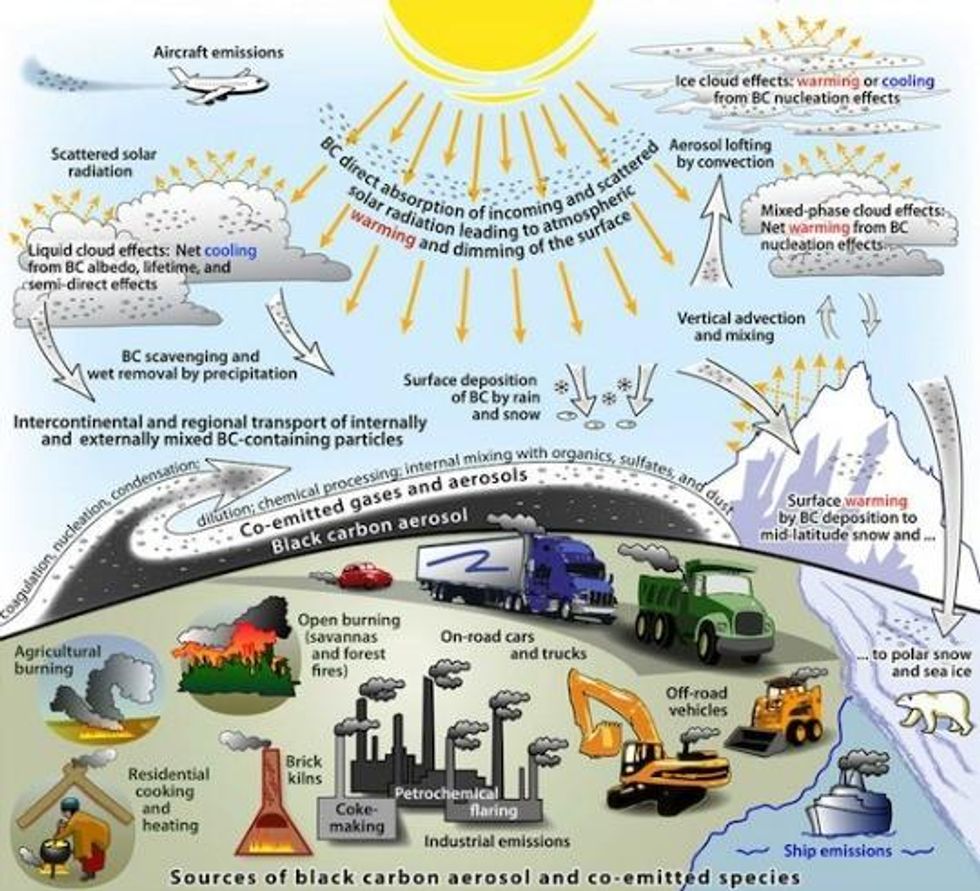Burning World's Forests and Grasslands Warming Earth Faster Than Thought: Study
New study shows that 'black carbon' soot emissions having much more harmful impact than earlier estimates
According to a new study, black carbon emissions--or 'soot'--generated from burning the world's forests, grasslands and diesel exhaust may have twice the impact on rising temperatures and global warming than previously thought.
And, given the amount of soot emitted each year globally, successful efforts to reduce such pollution could have widespread impact in terms of addressing the role it plays in climate change, say researchers.
Durwood Zaelke, president of the Institute for Governance and Sustainable Development, told the Washington Post that reducing soot emissions "could save lives" and produce impressive results in terms of "cooling" a warming planet.
The study (pdf), published in the Journal of Geophysical Research Atmospheres, suggests that pollution from soot could be even more harmful than methane, widely cited in scientific circles currently as the second-most impactful and most singularly potent of the greenhouse gasses.
According to the study's abstract, "We estimate that black carbon ... is the second most important human emission in terms of its climate-forcing in the present-day atmosphere; only carbon dioxide is estimated to have a greater forcing."
Black carbon is a significant cause of the rapid warming in the Northern Hemisphere at mid to high latitudes, including the northern United States, Canada, northern Europe and northern Asia, the report finds, but impacts can also be felt farther south, inducing changes in rainfall patterns from the Asian Monsoon.
"There are exciting opportunities to cool climate by reducing soot emissions but it is not straightforward," said the report's co-author Professor Piers Forster of the University of Leeds' School of Earth and Environment.
The Guardian reports that about 7.5 million tons of man-made soot was released in 2000 alone, with a greenhouse effect two-thirds that of carbon dioxide, and greater than methane. The Guardian continues:
The biggest source of soot emissions is the burning of forest and savannah grasslands. But diesel engines account for about 70% of emissions from Europe, North America and Latin America.
In Asia and Africa, wood burning domestic fires make up 60% to 80% of soot emissions. Coal fires are also a significant source of soot in China, parts of Eastern Europe, and former Soviet bloc countries.
The four-year study, led by the International Global Atmospheric Chemistry Project, notes that emissions in some regions are probably even higher than estimates.
While mitigating black carbon will help curb short-term climate change, "to really solve the long-term climate problem, carbon dioxide emissions must also be reduced," co-lead author Tami Bond of the University of Illinois at Urbana-Champaign said.

An Urgent Message From Our Co-Founder
Dear Common Dreams reader, The U.S. is on a fast track to authoritarianism like nothing I've ever seen. Meanwhile, corporate news outlets are utterly capitulating to Trump, twisting their coverage to avoid drawing his ire while lining up to stuff cash in his pockets. That's why I believe that Common Dreams is doing the best and most consequential reporting that we've ever done. Our small but mighty team is a progressive reporting powerhouse, covering the news every day that the corporate media never will. Our mission has always been simple: To inform. To inspire. And to ignite change for the common good. Now here's the key piece that I want all our readers to understand: None of this would be possible without your financial support. That's not just some fundraising cliche. It's the absolute and literal truth. We don't accept corporate advertising and never will. We don't have a paywall because we don't think people should be blocked from critical news based on their ability to pay. Everything we do is funded by the donations of readers like you. Will you donate now to help power the nonprofit, independent reporting of Common Dreams? Thank you for being a vital member of our community. Together, we can keep independent journalism alive when it’s needed most. - Craig Brown, Co-founder |
According to a new study, black carbon emissions--or 'soot'--generated from burning the world's forests, grasslands and diesel exhaust may have twice the impact on rising temperatures and global warming than previously thought.
And, given the amount of soot emitted each year globally, successful efforts to reduce such pollution could have widespread impact in terms of addressing the role it plays in climate change, say researchers.
Durwood Zaelke, president of the Institute for Governance and Sustainable Development, told the Washington Post that reducing soot emissions "could save lives" and produce impressive results in terms of "cooling" a warming planet.
The study (pdf), published in the Journal of Geophysical Research Atmospheres, suggests that pollution from soot could be even more harmful than methane, widely cited in scientific circles currently as the second-most impactful and most singularly potent of the greenhouse gasses.
According to the study's abstract, "We estimate that black carbon ... is the second most important human emission in terms of its climate-forcing in the present-day atmosphere; only carbon dioxide is estimated to have a greater forcing."
Black carbon is a significant cause of the rapid warming in the Northern Hemisphere at mid to high latitudes, including the northern United States, Canada, northern Europe and northern Asia, the report finds, but impacts can also be felt farther south, inducing changes in rainfall patterns from the Asian Monsoon.
"There are exciting opportunities to cool climate by reducing soot emissions but it is not straightforward," said the report's co-author Professor Piers Forster of the University of Leeds' School of Earth and Environment.
The Guardian reports that about 7.5 million tons of man-made soot was released in 2000 alone, with a greenhouse effect two-thirds that of carbon dioxide, and greater than methane. The Guardian continues:
The biggest source of soot emissions is the burning of forest and savannah grasslands. But diesel engines account for about 70% of emissions from Europe, North America and Latin America.
In Asia and Africa, wood burning domestic fires make up 60% to 80% of soot emissions. Coal fires are also a significant source of soot in China, parts of Eastern Europe, and former Soviet bloc countries.
The four-year study, led by the International Global Atmospheric Chemistry Project, notes that emissions in some regions are probably even higher than estimates.
While mitigating black carbon will help curb short-term climate change, "to really solve the long-term climate problem, carbon dioxide emissions must also be reduced," co-lead author Tami Bond of the University of Illinois at Urbana-Champaign said.

According to a new study, black carbon emissions--or 'soot'--generated from burning the world's forests, grasslands and diesel exhaust may have twice the impact on rising temperatures and global warming than previously thought.
And, given the amount of soot emitted each year globally, successful efforts to reduce such pollution could have widespread impact in terms of addressing the role it plays in climate change, say researchers.
Durwood Zaelke, president of the Institute for Governance and Sustainable Development, told the Washington Post that reducing soot emissions "could save lives" and produce impressive results in terms of "cooling" a warming planet.
The study (pdf), published in the Journal of Geophysical Research Atmospheres, suggests that pollution from soot could be even more harmful than methane, widely cited in scientific circles currently as the second-most impactful and most singularly potent of the greenhouse gasses.
According to the study's abstract, "We estimate that black carbon ... is the second most important human emission in terms of its climate-forcing in the present-day atmosphere; only carbon dioxide is estimated to have a greater forcing."
Black carbon is a significant cause of the rapid warming in the Northern Hemisphere at mid to high latitudes, including the northern United States, Canada, northern Europe and northern Asia, the report finds, but impacts can also be felt farther south, inducing changes in rainfall patterns from the Asian Monsoon.
"There are exciting opportunities to cool climate by reducing soot emissions but it is not straightforward," said the report's co-author Professor Piers Forster of the University of Leeds' School of Earth and Environment.
The Guardian reports that about 7.5 million tons of man-made soot was released in 2000 alone, with a greenhouse effect two-thirds that of carbon dioxide, and greater than methane. The Guardian continues:
The biggest source of soot emissions is the burning of forest and savannah grasslands. But diesel engines account for about 70% of emissions from Europe, North America and Latin America.
In Asia and Africa, wood burning domestic fires make up 60% to 80% of soot emissions. Coal fires are also a significant source of soot in China, parts of Eastern Europe, and former Soviet bloc countries.
The four-year study, led by the International Global Atmospheric Chemistry Project, notes that emissions in some regions are probably even higher than estimates.
While mitigating black carbon will help curb short-term climate change, "to really solve the long-term climate problem, carbon dioxide emissions must also be reduced," co-lead author Tami Bond of the University of Illinois at Urbana-Champaign said.


